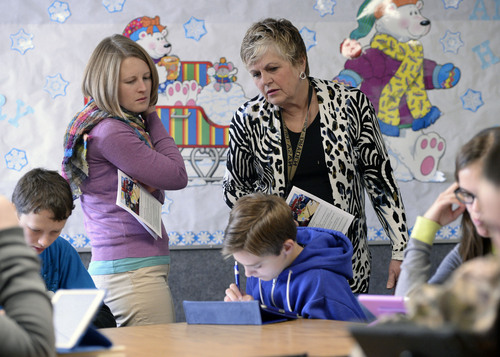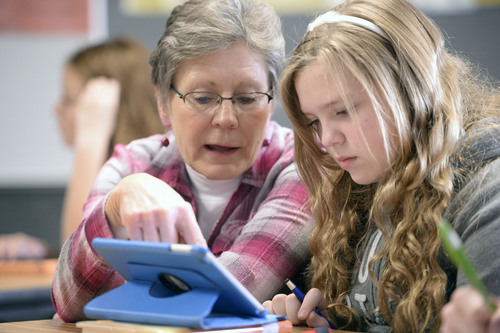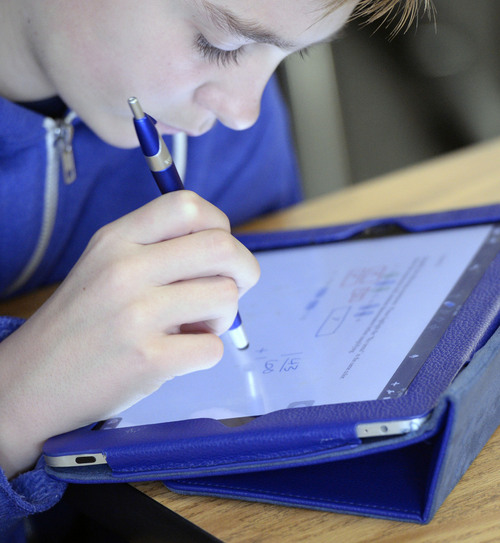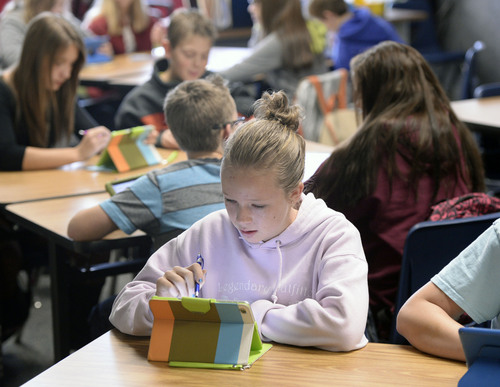This is an archived article that was published on sltrib.com in 2014, and information in the article may be outdated. It is provided only for personal research purposes and may not be reprinted.
Nephi • A new middle school math textbook developed by Utah educators to work with or without electronic devices is a "game changer," Lt. Gov. Spencer Cox said Friday.
"This is Utah people solving Utah problems," Cox told educators from Juab Junior High School, the San Juan District and Eisenhower Junior High School, which are all piloting the new textbook, as well as the University of Utah-led team that developed Utah Middle School Math, as the text is called.
As Cox toured Juab Junior High, seventh-graders solved math problems by using their fingers or styluses to write on iPad Minis, and eighth-graders worked first in paper workbooks and then on iPads.
Teachers had students, with a single click, post their work to classroom white boards for all to see. The teachers used iPads to demonstrate how problems could be solved.
Utah Middle School Math is not a traditional hardbound textbook.
Rather, it is a series of "chapters" that can be downloaded, free of charge, by any teacher, student or parent onto any computer or device. Users can use the chapters interactively online, print them out or purchase them in a softbound workbook format for $2.69.
The Utah Legislature funded the project to develop Utah Middle School Math. While the U. is in the lead, educators from other colleges and universities as well as middle schools also are involved.
A separate program to develop a text and accompanying materials for high schools, the Mathematics Vision Project, also involves Utah educators from higher education and public schools.
—
A math gap • When the state Board of Education adopted the new Utah Core Curriculum, schools didn't have much time to prepare.
Some middle schools adopted the new standards in the fall of 2011, and the rest followed the next year. The standards are more rigorous and expect students to go deeper into certain concepts.
Existing textbooks were not designed for the new standards, and there were no materials online tailored for them either. Teachers cobbled together teaching materials.
"I felt like I was a brand new teacher," said Eve Serr, who was in her eighth year teaching math when her Jordan District middle school adopted the core standards. She is now one of the writers for the new text.
Teachers were frustrated and that filtered down to the students and their parents.
Two years on, the curriculum turmoil has settled down and many are using Utah Middle School Math, whether they're in the pilot or not.
Ken Rowley, principal at Juab Junior High, said he has had far fewer calls from parents perplexed by math instruction this year.
The U. co-directors of the project — Hugo Rossi and Maggie Cummings — believe it will be adopted in most Utah middle schools in the coming years.
The cost, if a school were to buy softbound workbooks for every chapter for every student, is still lower than the $30,000 per year a typical junior high spends on a text, Cummings said.
—
'I love this' • When Sen. Aaron Osmond, R-South Jordan, proposed the 2012 legislation to fund the new text, he was looking for something that would teach to Utah's new core standards, be low cost for schools, interactive so parents could help kids at home and available in print or online.
On Friday, Osmond, Sen. Howard Stephenson, R-Draper, and others saw the interactive aspect at Juab Junior High.
Juab School District had already laid the technological groundwork by spending one-time funding from the Legislature in 2008 on computer labs and equipping schools with wireless Internet, Rowley said.
For three years now, every middle schooler has been given a personal electronic device to use throughout the school year. Beginning next year, every student in seventh through 12th grades will have iPad Minis; those in third through sixth grades will have iPods.
The junior high's paper costs have fallen nearly 60 percent since the students began working on iPads and iPods, Rowley said.
"I love this a lot more," said Robyn Sherwood, a seventh-grade honors math student who uses her iPad Mini in math and English, but can also take photos of her hand-written history notes to study later.
She even did her homework on a plane to Mexico without having to lug a heavy text. "It's a lot easier," she said.
Sadie Asbridge, also a seventh-grade honors math student, said she can take a screen shot of a problem that's giving her trouble and email it to her teacher, Jill Jackson, from home at night.
"I usually get a response," she said. "Then you don't have the embarrassment of having it in front of everyone."
Other schools involved in the pilot project do not have electronic devices for all their students, but they've embraced Utah Middle School Math.
For one thing, most schools allow the students to write in the workbooks, a big advantage over the traditional hardbound books passed down from year to year, teachers said.
"I feel like they're getting a much deeper understanding," said Kara Boyd, who teaches seventh- and eighth-grade math at Monticello High.
Mary Rhodes, principal of Eisenhower Junior High School, said she's optimistic the new text will help her students close a gap in their end-of-year math scores.
"The kids are learning concepts that evaded them before," Rhodes said.
Rowley said he couldn't be more pleased with the new core standards and the text for teaching them.
"It's not teaching them to get the right answers," he said. "It's teaching them to solve problems."
Twitter: @KristenMoulton











